Meat ingredients in industrial animal diets and their benefits for pets

The world is changing. Every day, big changes occur in every aspect of life, and the global impression of these changes causes people to endure significant stress. In such conditions, it is easy to get confused by the enormous flow of different information.
For example, global consumer goods markets are changing, some processes are not covered by legislation, and this gives rise to one myth or another. Today, let's talk about a number of myths that exist in the field of industrial cat and dog nutrition.
It is not uncommon to see "55% fresh duck fillet" or "70% turkey meat" on food packages. There are even "fresh venison", "boar meat" and other hunting exotics. Such a menu makes the owners "drool"! But two questions arise. First: Is what people drool over perfect for cats? And second: is this 55% and 70% real?
Cat and human bodies are completely different. Therefore, no matter how much our ears like beautiful descriptions, a responsible owner will always choose what is good for the animal. Let's get to the bottom of this.

Peculiarities of the feed production process
Today, the production of dry industrial rations is based on the extrusion process. Extrusion is the technology of obtaining products by forcing a viscous melt of material or a thick paste (fine mixture) through a forming hole (matrix). To obtain the desired product, the feed is processed in the extruder at a higher pressure and for a certain amount of time.1
In the process of feed production, ingredients of animal and plant origin are mixed, undergoing various changes - primarily biochemical. A change in pressure potential causes an "explosion" of the product as it exits the extruder, radically and permanently changing its characteristics. These changes are beneficial – they are what ensure that the industrial diet can be assimilated at a high level.
Increased temperature and pressure allow to "simplify" the structure of proteins, fats and carbohydrates and increase their inaccessibility to the body of animals.

Raw materials for feed production
Dehydrated meat
Dehydrated meat, in other words, meat meal, is used as the main source of animal protein in feed. Meat has been dried long before refrigerators and freezers were created, making it one of the earliest canning techniques.
All the ingredients for the meat meal come from meat slaughterhouses. At the same time, a good meat meal based on, for example, chicken does not contain beaks, paws and feathers. There are some kinds of meats that contain limited amounts of bone - calcium, which, among other things, is found in bones, is an important component of domestic animal nutrition,so including these ingredients in food in limited amounts can be beneficial. In this case, however, they are defined as meat and bone, not meat.
During processing, the meat trimmings are completely dehydrated / dried and ground into fine flour. This is done shortly after the animal is slaughtered, the meat is well-preserved, and the feed produced from it remains of good quality throughout its shelf life. It should also be noted that dehydrated meat is a much more concentrated product than meat paste or meat itself. So keep this in mind if you decide to compare a meat meal-based pet food with a slurry meat-based pet food.2

Meat hydrolyzate
This ingredient is also used quite often and is the result of hydrolysis of animal or vegetable proteins in liquid or powder form. In the production of hydrolyzate protein, raw materials are treated with enzymes, destroying proteins to peptides and free amino acids, and then evaporated at a low temperature, concentrating the solution or drying to a dry residue.
Sometimes it is used as a nutritional component: it is believed that the hydrolyzed protein is well digested. But more often, animal protein hydrolysate acts as a powerful flavor component that can enhance the flavor and attractiveness of the finished feed.
Manufacturers themselves treat this ingredient with caution - you have to be 100% sure of the quality, because it is unknown what kind of raw material was taken as a basis. At BOWL WOW, we took a long time to check the raw material suppliers ourselves before we started using hydrolysates in our formulas.
In most cases, hydrolysate is added to the feed in small quantities and is not listed among the first five ingredients, but at the end of the list, that is, it does not form the basis of the feed. Sometimes both plant and animal hydrolysates are used as nutritional ingredients and sources of protein. In this case, hydrolyzed protein may be listed either among the first five ingredients of the feed or in the positions closest to them.3
Often, manufacturers write "fresh meat" in the composition, but in fact, most likely, they mean hydrolysate.
- Hydrolysate is usually of high cost, in large quantities it is not reasonable to use, so this point should be paid attention to when choosing a feed: if the amount of hydrolysate is high, and the price of the feed is standard, then most likely there is some inaccuracy and dishonesty on the part of the manufacturer.
- Hydrolysate has a good effect on the taste and flavor characteristics of the ration and can be used in an amount of 10-15%. This is utterly justified, and in this case we can talk about an ingredient of high quality, as its use is economically feasible.
- It should be understood that if liquid hydrolysate is used, the water evaporates during production, and the nutritional value of liquid hydrolysate is initially lower than that of dehydrated meat. This means that the more water in a diet, the lower its nutritional value per unit weight. Suppose 100 grams of a certain feed contains 10 grams of protein and 75 grams of water. Consequently, 100 g of feed contains 10% protein. If you subtract the water content, the remaining 25 g of dry matter contains 10 g of protein. If we express the protein content in the dry matter of this feed, then 10 g of protein is contained in 25 g of dry matter of the feed, and the feed contains 40% protein per dry matter.

Dehydrated eggs
This ingredient is also often used as an animal protein. In addition, eggs are an excellent source of choline, a nutrient that plays an important role in cell function, including brain function, as well as lutein and zeaxanthin, two antioxidants that help preserve vision. Do not forget that there are vegetable proteins, which are also necessary for the body of the pets, their sources are cereals, grains and other plant crops. They have long been used by man for food, which he shared with his pet helpers.


Horns, hooves, duck fillets and deer meat
The scare stories about "horns and hooves" in feeds are, of course, a myth. Any self-respecting manufacturer who works within the system of state product safety declaration uses raw materials from honest and reliable suppliers, and these raw materials are of excellent quality. This information is easy to check if you want. Therefore, there can be no doubt about dehydrated meat - it is useful and can rightfully be used as the number one ingredient in feed.
However, those manufacturers who list fresh fillets as part of the diet are most likely disingenuous. Do the math, first of all, for example, to provide at least 20% of fresh chicken or a difficult-to-maintain turkey for 100 tons of feed, 20 tons of fresh fillet would be required - the price for such fillets is extremely high, in addition, according to rosng.ru, only in 2021 chicken production in Russia has decreased by 6.4%. Secondly, in the process of processing the meat will still need to deprive the moisture, and this is an additional cost.
Even if the availability of animal protein in the feed would be 100% fresh raw material, it would be dried, ground and extruded in the production process. And as a result, it would be almost no different from the meat meal or dehydrated meat. Therefore, dehydrated meat/meat meal is a great and safe ingredient that has excellent bioavailability for our pets. As we continue to talk about fresh meat in feed, there is another point to be made.
When a manufacturer claims to use meat such as duck, venison or wild boar, it begs the question: is it possible in principle to ensure a sufficient amount of them in the composition? All of the above meats are not available a priori on an industrial scale and such feed would be, without exaggeration, "golden" for the consumer.
So it seems to us that statements about "55% duck fillet" in the composition are some exaggeration and slyness. Moreover, when feeding meat or hydrolysate into the extruder, they have to be dried, ground and turned into essentially the same meat meal. This is an additional cost, and if manufacturers who openly claim fresh meat really did have it in the specified amount, the actual cost of the product on the shelf would be higher by at least 45-50%.
Separately, it is worth mentioning that in addition to the problem with the actual content of fillets in the composition, there is also the problem of digestibility and usefulness. Consider, for example, the "fillet of marbled beef" content in the feed. It should be remembered that marbled beef is high in fat (up to 23% in terms of dry matter), which will quickly enough сause liver problems to a pet and entail lengthy treatment and increased costs. Is it good? Yes. True? Not a fact. Useful? No.
At the same time, we understand that today there are not enough regulations that would require manufacturers to display the actual composition on the packaging for the convenience of the consumer. The conclusion suggests itself: those producers who will sooner come to a responsible and honest approach in the composition of the ingredients base, will have a higher credibility to their brand and more prospects for commercial success.

Our findings
According to Lewis LD, Morris ML Jr, Hand MS.d4 we can calculate with high accuracy the daily energy requirement and the amount of a particular feed. For this, we only need to know the parameters of calories, and the daily requirement is calculated mathematically.
By the way, the average calorie content of super-premium diets is 350-400 kcal per 100 grams. From this it is easy to conclude that feeding a quality diet that is balanced in all nutrients also avoids overfilling the gastrointestinal tract.
A balanced mix of proteins, fats and carbohydrates (meat, egg, vegetable proteins, fats and carbs, etc.) is healthier for the body of a healthy cat and a wonderful pet dog, but fresh meat is useful and appropriate if it is actually added in documented amounts. It is important to remember the quality of such raw materials and the fact that the cost of the product will increase in proportion to its volume.
Remember that "beautiful" compositions are not always true, and choose what is healthier for your pet from those manufacturers who can really guarantee strict quality control and honest composition of their products!
We wish you and your pets excellent health!
—————————————————
[1] https://xn--d1acnpjccdbkm9i.xn--p1ai/stati/protsess-pererabotki-syrya-v-ekstrudere
[2] https://aller-petfood.com/ru/news-and-knowledge
[3] https://feedsmart.ru/ingredienty/gidrolizat-belka
[4] L.D. Lewis, M. L. Morris (JR), M. S. Hand c.



